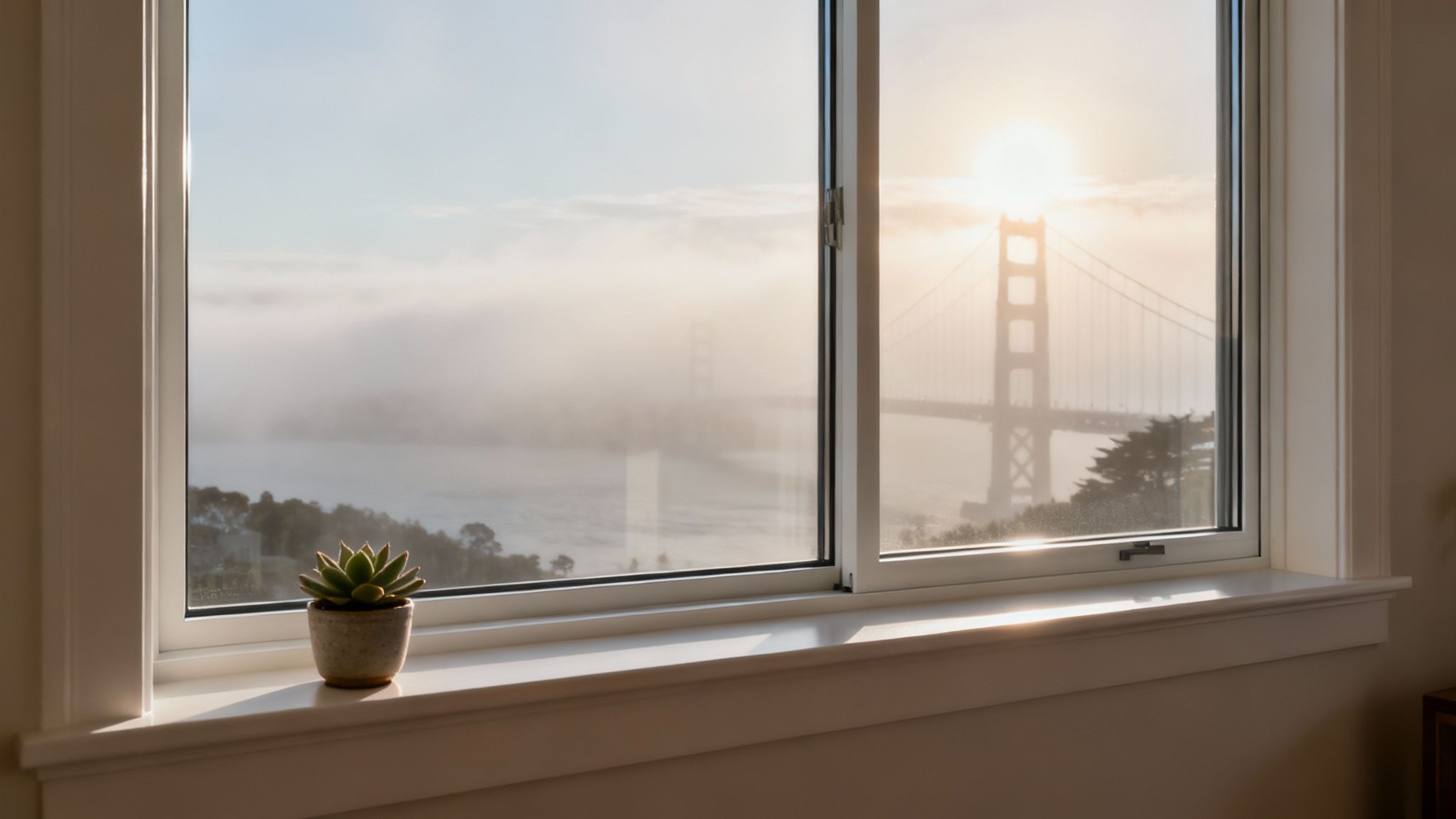As the Bay Area shifts from sunny days to cooler, wetter months, homeowners and contractors change their focus. Fall is the best time for weatherproofing in the bay area, with projects that protect homes from moisture and improve energy efficiency before winter. Taking action now can prevent expensive water damage, stop drafts, and make your home more comfortable. For builders in Berkeley and Oakland, this means more demand for durable, weather-resistant materials.
This guide lists the top fall projects that make a real difference. We will cover eight important upgrades to protect your home from the Bay Area's unique weather. You will find clear steps, material suggestions, and advice tailored to our local homes and climate. From sealing air leaks around windows to checking your insulation, each project is a manageable task. It is also a good time to winterize your house plumbing to protect against burst pipes.
1. Seal Air Leaks with Weatherstripping and Caulking
Sealing air leaks around doors and windows is one of the most cost-effective weatherproofing in the Bay Area: fall projects that make a difference. It helps your home handle the Bay Area's temperature swings, from foggy mornings to sunny afternoons. A well-sealed home is more comfortable and uses less energy.

This project uses two key materials: weatherstripping and caulk. Weatherstripping seals moving parts like doors and windows. Caulk fills stationary cracks and gaps. A PG&E study showed that proper air sealing can lower heating and cooling costs by about 15% for Bay Area homes.
Benefits of Air Sealing in the Bay Area
In coastal areas like Berkeley and Oakland, wind-driven rain is a big concern. Gaps around windows and doors are the main way water gets in, which can cause mold and rot. Sealing these gaps is your first line of defense against our damp winters.
How to Seal Air Leaks
Follow these steps for a professional-quality seal:
- Find the Leaks: On a windy day, feel for drafts around window frames, doors, and where pipes enter your home. You can also use a lit incense stick and watch where the smoke wavers to find leaks.
- Clean the Area: For a good seal, the surface must be clean. Remove old, cracked caulk and worn-out weatherstripping. Clean the area to remove all dust and grime.
- Choose the Right Materials:
- Caulk: For outside gaps, use a high-quality silicone or elastomeric caulk that is paintable and can handle temperature changes.
- Weatherstripping: EPDM rubber and silicone types are durable and resist moisture well. For doors, add a new door sweep to block drafts at the bottom.
Pro Tip: Apply caulk and other sealants on a dry, mild day. This helps the materials stick properly and cure, making them more effective against winter storms.
For help choosing the best weatherstripping and caulk, the team at Truitt & White can guide you to professional-grade solutions.
2. Upgrade and Seal Your Windows
Replacing old, single-pane windows with modern, energy-efficient ones is a major step in weatherproofing in the Bay Area: fall projects that make a difference. Old windows are a big source of heat loss in winter. An upgrade will keep your home's temperature stable and protect it from rain and drafts.

This project involves replacing windows or adding low-emissivity (Low-E) films to existing ones. Brands like Marvin and Andersen offer double-pane windows that greatly improve insulation. According to Energy Star, upgrading from single-pane windows can save Bay Area homeowners between $101 and $583 each year.
Benefits of Energy-Efficient Windows in the Bay Area
The Bay Area’s cool, damp winters are hard on windows. Old, poorly sealed windows not only leak air but can also get condensation, leading to mold and wood rot. This is a common problem in older homes from San Francisco to Berkeley. Upgrading your windows improves comfort and prevents moisture damage.
How to Upgrade Your Windows
Follow these steps for a successful window project:
- Inspect Your Windows: Check which windows are in the worst shape. Look for drafts, condensation between panes, or rotting frames. You can replace them in phases, starting with the ones that face the wind.
- Select the Right Windows: Choose windows with an NFRC label that are right for the Bay Area's climate. Look for a low U-factor for better insulation. You can learn more about the best windows for energy efficiency on truittandwhite.com.
- Ensure Proper Installation: Professional installation is very important. An incorrectly installed window can leak air and water. Make sure your contractor is certified and schedule the work before the rainy season starts.
Pro Tip: For historic homes, like Victorian houses in San Francisco, consider wood-clad windows. They keep the home's classic look while providing modern energy efficiency.
Whether you need high-performance Marvin windows or Andersen options, the experts at Truitt & White can help you choose the best units for your home.
3. Improve Attic and Roof Insulation
Upgrading attic insulation is a key part of weatherproofing in the Bay Area: fall projects that make a difference. Since warm air rises, a poorly insulated attic lets a lot of heat escape in the cooler months. Adding insulation creates a thermal barrier that keeps your home warm and lowers energy bills.

This project involves adding insulation, like blown-in cellulose or fiberglass batts, to meet recommended R-values. According to the Department of Energy, properly insulating your attic can cut heating bills by up to 20%. It's a smart investment for the Bay Area's chilly, damp winters.
Why Attic Insulation is a Priority
The Bay Area's big temperature swings from day to night make heating systems work hard. Good insulation keeps the indoor temperature stable. It also helps prevent moisture and condensation in the attic, which can lead to mold and rot.
How to Enhance Your Insulation
Follow these steps for an effective insulation project:
- Get an Energy Audit: Before you start, consider hiring a professional for an energy audit. They can find where you're losing the most heat and tell you how much insulation you need.
- Seal Air Leaks First: Insulation slows heat loss, but it doesn't stop air leaks. Use caulk or spray foam to seal gaps around lights, pipes, and wiring before adding new insulation.
- Check for Proper Ventilation: A well-insulated attic also needs good ventilation. Make sure vents are clear so air can flow, which prevents moisture damage.
- Choose the Right Materials:
- Fiberglass Batts: Good for attics with standard spacing between joists.
- Blown-In Cellulose or Fiberglass: Great for filling odd-shaped spaces and adding insulation over existing layers.
Pro Tip: Many older Bay Area homes may have asbestos in the old insulation. Always have a professional check for asbestos before you remove or disturb any materials.
To understand how insulation works, you can learn more about R-value and insulation on truittandwhite.com. Truitt & White offers professional-grade insulation to meet your home's needs.
4. Weatherproof Your Doors and Thresholds
Exterior doors protect your home, but worn-out seals can let in drafts and moisture. Door and threshold weatherproofing is an important part of weatherproofing in the Bay Area: fall projects that make a difference. This project involves replacing old weatherstripping, adding door sweeps, and fixing thresholds to create an airtight seal.
A well-sealed door stops wind-driven rain and keeps heated or cooled air inside. This simple upgrade can lower utility bills and is a key task to get your home ready for the wet season. As part of a whole-home strategy, you might also explore the best insulated garage doors for another common entry point.
Why Door Sealing is a Bay Area Priority
Fall in the Bay Area brings more moisture and wind. Unsealed doors are a major source of water intrusion, especially at the bottom, which can damage floors. For historic homes, sealing these gaps helps preserve the structure while improving energy efficiency.
How to Weatherproof Your Doors
Follow these steps to seal your exterior doors:
- Inspect and Measure: Close the door and look for light coming through the frame or underneath. Check for gaps in the weatherstripping. Measure these gaps before you buy new seals.
- Remove Old Materials: Pull off old weatherstripping. Use a putty knife to clean any leftover adhesive from the door frame so the new seal will stick well.
- Install New Seals and Sweeps:
- Weatherstripping: Apply new self-adhesive foam or vinyl weatherstripping along the top and sides of the door jamb.
- Door Sweep: Install a new sweep along the bottom of the door to block drafts.
- Threshold: If your threshold is damaged, replace it with an adjustable one to create a tight seal.
Pro Tip: After installing new seals, check that the door closes snugly but doesn't require force. A seal that is too tight can strain the hinges and latch.
Visit Truitt & White for durable, professional-grade door seals, sweeps, and thresholds designed to withstand Bay Area weather.
5. Clean and Maintain Your Gutters
Ignoring your gutters can lead to water damage during the Bay Area's rainy season. An essential fall project is to inspect, clean, and repair your gutters and downspouts. A working gutter system protects your foundation, siding, and basement from water damage.
This project makes sure rainwater is carried away from your home's structure. In our region, a single storm can bring inches of rain. Clogged gutters can overflow and saturate the ground around your foundation, which can cause serious structural problems.
Importance of Gutter Maintenance for Local Homes
From San Francisco's historic homes to Berkeley's hillside properties, uncontrolled water is a major threat. Clogged gutters can cause water to get behind siding, leading to mold and rot. Well-maintained gutters also prevent soil erosion that can weaken foundations on sloped lots.
How to Maintain Your Gutter System
Follow these steps to get your gutters ready for winter:
- Clear Debris: Use a ladder, gloves, and a trowel to remove leaves and muck from your gutters. Then, flush the gutters with a hose to make sure water flows freely through the downspouts.
- Inspect for Damage: Look for cracks, rust, or sagging sections. Pay close attention to the seams where gutter sections meet, as they often leak.
- Repair and Reinforce:
- Leaks: Use a waterproof sealant to fix any small holes or cracks.
- Sagging: Re-secure loose gutter hangers to ensure the gutters slope toward the downspouts.
- Downspouts: Make sure downspouts direct water at least four to six feet away from the foundation.
Pro Tip: Consider installing gutter guards after cleaning. They won't eliminate maintenance, but they will reduce how often you need to clean your gutters, especially if you have trees nearby.
This is a key part of our guide to September home maintenance. Visit Truitt & White for high-quality sealants and tools to prepare your gutters.
6. Waterproof Your Foundation and Basement
Protecting your home's foundation is a vital part of weatherproofing in the Bay Area: fall projects that make a difference. The region's clay soil and winter rains mean that even small foundation cracks can let water into basements and crawlspaces. This can cause structural damage and create a breeding ground for mold.
This project includes sealing cracks, applying waterproof coatings, and ensuring proper drainage. For Bay Area homes, especially those on hills or in low-lying areas, foundation waterproofing is essential before the rainy season. It can prevent much more expensive repairs later on.
Why Foundation Waterproofing Matters Here
Many Bay Area homes are at risk from hydrostatic pressure, which is when wet soil pushes water against foundation walls. Proactive waterproofing is the best way to protect against this force and preserve your property's value and safety.
How to Protect Your Foundation
Follow these steps to create a strong moisture barrier:
- Inspect Your Foundation: Before it rains, check your foundation and basement walls for cracks or signs of water. Look for a white, powdery residue called efflorescence, which indicates moisture.
- Seal Cracks and Gaps: Use a high-quality polyurethane or epoxy sealant to fill any cracks in the concrete. These materials create a permanent, watertight bond.
- Improve Exterior Drainage:
- Grading: Make sure the soil around your foundation slopes away from the house. This directs surface water away from the walls.
- Gutters and Downspouts: Clean your gutters and check that downspouts extend at least six feet from the foundation.
Pro Tip: For homes in areas with a high water table, a sump pump with a battery backup is a smart investment. It actively pumps out water and provides protection even during a power outage.
The experts at Truitt & White can help you choose the right sealants and coatings. If you already have moisture issues, you can find expert tips for wall repair after water damage.
7. Maintain and Optimize Your HVAC System
Servicing your HVAC system is a key part of weatherproofing in the Bay Area: fall projects that make a difference. Our mild winters still require an efficient heating system to handle the cool, damp weather. A well-maintained HVAC unit keeps your home comfortable without wasting energy.
This project includes a professional tune-up, filter replacement, and duct inspection. A properly working system provides reliable heat and improves indoor air quality. Regular maintenance can reduce heating costs by 5-10% and prevent expensive emergency repairs.
Why HVAC Maintenance is a Bay Area Priority
Homes across the Bay Area rely on their heating systems to manage the damp winter chill. An inefficient system uses more energy and provides uneven heating. Keeping your HVAC system in top shape is important for both your wallet and the environment.
How to Prepare Your Heating System
Follow these steps to get your HVAC ready for the season:
- Schedule Professional Servicing: Book a tune-up with an HVAC technician in early fall before they get busy. They will inspect your furnace, clean parts, and make sure it runs safely and efficiently.
- Replace Air Filters: A clogged filter makes your system work harder. Replace it before you turn on the heat for the first time, and check it monthly during the heating season.
- Use Smart Technology:
- Programmable Thermostats: Set a schedule to lower the heat when you're away or asleep.
- Smart Thermostats: These devices learn your habits and adjust the temperature automatically, saving energy.
- Clear Vents: Make sure furniture, rugs, or drapes are not blocking your heating vents. This allows air to circulate properly.
Pro Tip: Don't wait for the first cold day to find out your furnace has a problem. Early fall maintenance ensures your system is reliable and helps you avoid emergency calls.
Truitt & White can recommend trusted local HVAC professionals to keep your home comfortable all winter.
8. Repair Siding and Caulk the Exterior
Protecting your home's exterior walls is a crucial step in weatherproofing in the Bay Area: fall projects that make a difference. Your siding is the first line of defense against rain and moisture. Repairing damaged siding and renewing old caulk prevents water from getting inside and causing problems like rot and mold.
This project involves two main actions: caulking joints and seams, and replacing any damaged siding panels. For the Bay Area's varied architecture, maintaining the exterior is important for both the structure and its appearance. Sealing these weak spots before the wet season is much cheaper than fixing water damage later.
Why Siding Maintenance is a Local Priority
The Bay Area's winter weather, with its rain and wind, is tough on siding. Small cracks or failed caulk can let water into the wall. This can lead to dry rot, a common and destructive problem in our area. A well-maintained exterior keeps moisture out and protects your home.
How to Maintain Your Siding
Follow these steps to get your home's siding ready for winter:
- Inspect Your Exterior: Walk around your home and look at all siding and trim. Check for cracks, gaps, peeling paint, or signs of moisture damage. Pay close attention to areas around windows and doors.
- Remove Old Caulk: Before applying new sealant, remove any old, brittle caulk. Clean the joint so the new caulk will stick well.
- Repair or Replace Damaged Siding: Carefully remove any damaged siding. Make sure the weather barrier underneath is in good shape before installing new siding. This is a critical step to prevent wood rot.
- Apply High-Quality Exterior Caulk: Choose a caulk that is right for your siding material and will stay flexible. Apply a smooth, even bead to all gaps and joints.
Pro Tip: Apply exterior caulk and paint on a dry, mild day when temperatures are between 50°F and 85°F. This helps the materials cure properly and create a durable, watertight seal.
Visit Truitt & White for the right siding materials and high-performance caulks that can handle local weather challenges.
Fall Weatherproofing Projects at a Glance
| Project | Difficulty | Cost | Key Benefit | Best For | Pro Tip |
|---|---|---|---|---|---|
| Air Sealing | Easy | $50 – $300 | 10-20% energy savings | Drafty windows/doors | Apply in dry weather. |
| Window Upgrades | Hard | $3k – $12k+ | 20-30% energy savings | Old, single-pane windows | Get multiple quotes. |
| Attic Insulation | Medium | $1.5k – $4k | Prevents 20-25% heat loss | Poorly insulated attics | Seal leaks first. |
| Door Sealing | Easy | $100 – $500 | Stops drafts immediately | Exterior doors | Check door closes easily. |
| Gutter Cleaning | Easy-Medium | $200 – $600 | Prevents foundation damage | Homes with trees | Clean before fall rains. |
| Foundation Sealing | Hard | $2k – $15k+ | Prevents structural damage | Flood-prone areas | Improve soil grading. |
| HVAC Maintenance | Medium | $150 – $500/yr | 10-15% more efficient | All homes with central HVAC | Service in early fall. |
| Siding Repair | Medium | $300 – $2k+ | Prevents water intrusion | Homes with aged siding | Apply caulk at 50-85°F. |
Your Next Steps for a Weather-Ready Home
As fall arrives in the Bay Area, it's time for proactive home maintenance. This guide has covered the most important projects, from sealing small drafts to protecting your foundation. Each task helps create a more durable, efficient, and comfortable home.
By focusing on these key areas, you're not just getting ready for winter—you're investing in your property's value. These projects form a complete defense against our local climate's unique challenges. Ignoring them can lead to bigger, more expensive problems later on.
Key Takeaways for Your Fall Plan
Here are the most important points to remember:
- Seal the Envelope First: The best weatherproofing starts with your home's exterior. Sealing small gaps around windows, doors, and siding saves energy and keeps water out.
- Think Top-Down and Bottom-Up: Water damage often starts at the roof and foundation. Clean gutters protect from above, while foundation sealing protects from below.
- Don't Underestimate Insulation: Good insulation in your attic and walls keeps your home warm in the winter and cool in the summer. It's one of the most effective weatherproofing projects in the Bay Area that make a difference.
- Maintain Your Systems: Your HVAC system controls your home's climate. A fall tune-up ensures it runs efficiently and safely.
Turning Plans into Action
Now it's time to get started. Make a checklist based on the projects in this guide. Walk around your property to find cracks, peeling paint, or drafty spots.
Decide which tasks you can do yourself and which ones need a professional. For DIY projects, get your materials ready. For bigger jobs, schedule consultations with trusted local contractors now before their schedules fill up.
Remember, fall weatherproofing in the Bay Area is about preventing problems, not just reacting to them. By tackling these projects now, you can ensure your home is a warm and secure place all winter long.
Frequently Asked Questions (FAQ)
1. When is the best time to start fall weatherproofing in the Bay Area?
The best time to start is late summer or early fall, typically September and October. This gives you plenty of time to complete projects in mild, dry weather before the winter rains begin.
2. What is the most cost-effective weatherproofing project for an older Berkeley home?
For an older home in Berkeley, air sealing is the most cost-effective project. Sealing gaps around windows, doors, and utility penetrations with caulk and weatherstripping offers a high return on investment by significantly reducing drafts and energy loss for a minimal cost.
3. Do I really need to upgrade my windows if they are not broken?
Even if your windows aren't broken, old single-pane or early double-pane windows are very inefficient. Upgrading to modern, ENERGY STAR certified windows can reduce your energy bills, improve comfort, and decrease outside noise, making it a worthwhile investment.
4. Can I do foundation waterproofing myself?
Minor tasks like sealing small, visible cracks with an epoxy sealant can be a DIY project. However, more serious issues like major cracks or water intrusion often require professional help, which may involve excavation and specialized coatings.
5. How often should I clean my gutters in a place like Oakland with many trees?
In an area like Oakland with a lot of trees, you should inspect and clean your gutters at least twice a year. A cleaning in late spring and another in late fall after most leaves have fallen is a good schedule to prevent clogs.
Ready to start your fall projects? For expert advice and a full selection of premium building materials, from high-performance windows and doors to the best sealants and insulation, visit the team at Truitt and White. Stop by our Berkeley showroom for expert advice or contact us today. We have everything you need to prepare your home for winter.








